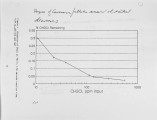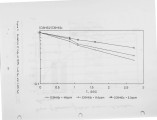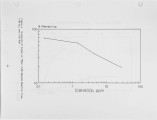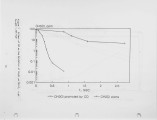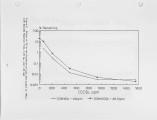| OCR Text |
Show For these experiments the analytical train consisted of a Bec kman model 400 hydrocarbon analyzer (i.e. a flame ionization detector,) a Teledyne De analyzer. and a Thermoelectron Model 48 Gas Filter Correlation CO Analyzer. Materials used in these e xperiments included benzene (Ba ker Analyzed Reagent), chlorobenzene (Baker Analyzed Reagent), methyl chloride (Matheson), nitrogen (Matheson Zero Gas ) , and Oxygen (Matheson ED). The FID and CO analyzer were calibrated daily with Matheson certified analyzed gas blends of CH4 in Ne and CO in Ne r espect ivel y . In using the FID concentration measurements were always done on a differential basis, i.e. the concentration of the CHaCl, C6H6 , or C6H~Cl was taken to be the difference between the reading of the FID with an input flow of CHaCl, CoHo , or CoH~Cl and the reading with that flow turned off. This differential technique greatly reduced problems due to zero drift, etc. Gaseous mixtures of 1320ppm CoHo in N2 and 1150ppm CoH~CI in N2 were prepared by evacuating a cylinder, vacuum transferring a measured volume of organic liquid into the cylinder, and pressurizing with N2 • Mixing was achieved by applying heating tape to the bottom and one side of the cylinder and allowing it to stand for several days. The three compound whose oxidation was studied, i.e. methyl chloride, chlorobenzene, and benzene, are all quite oxidation resistant, much more resistant than the intermediates they can form during oxidation. Consequently a measurement of the total amount of material remaining by flame ionization is effectively a measurement of the amount of the starting material remaining and provides greater sensitivity than would GC-FID. Two series of experiments were done. The purpose of the first series of experiments was to demonstrate the threshold effect discussed above, i.e. demonstrate that the specific rate of oxidation of each of the three organic compounds in trace concentration is much lower than would be predicted from literature measurements at higher concentrations. The purpose of the second series of experiments was to demonstrate that the specific rate at which trace quantities of each of these three organic compounds oxidize can be greatly enhanced by cooxidizing it with a higher concentration of some clean fuel. It is expected that in the practical application of this technology that clean fuel will be natural gas. The purpose of these experiments, however, was to demonstrate the principle and for that purpose it was much easier to use a fuel to which the FID is insensitive, i.e. CO. COMPUTER MODELING PROCEDURES The arguments given above are quite general; if it is true that one can force the oxidation of trace concentrations of a toxic organic to completion by injecting a small amount of some clean fuel, then one should also be able to force the oxidation of a one clean fuel to completion by injecting small amounts of a second clean fuel. The oxidation of CH4 and of CO are both very well studied processes whose 5 |













